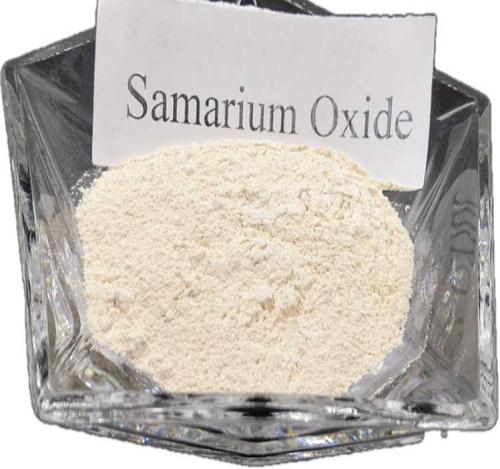| Identification | More | [Name]
Samarium oxide | [CAS]
12060-58-1 | [Synonyms]
SAMARIUM ATOMIC ABSORPTION STANDARD
SAMARIUM(III) OXIDE
SAMARIUM PLASMA EMISSION STANDARD
disamariumtrioxide
samaria
samarium(3+)oxide
samariumoxide(sm2o3)
samariumsesquioxide
samariumtrioxide
SAMARIUM(III) OXIDE, 99.99%
Samarium(III) oxide, 99.999% metals basis
SAMARIUM(III) OXIDE, 99.9%
SAMARIUM(III) OXIDE, NANOPARTICLES, 99.&
SAMARIUM(III) OXIDE, NANOPOWDER, <100NM, 99.9+%
SAMARIUM (III) OXIDE 99% NANOMETER GRADE
SAMARIUM (III) OXIDE (99.999%-SM) (REO) SPECTRO
SAMARIUM (III) OXIDE 99.99% (REO) POWDER
SAMARIUM (III) OXIDE 99.99% WAFER
SAMARIUM (III) OXIDE (99.9%-SM) (REO)
SAMARIUM (III) OXIDE 99.99% FOIL | [EINECS(EC#)]
235-043-6 | [Molecular Formula]
O3Sm2 | [MDL Number]
MFCD00011237 | [Molecular Weight]
348.72 | [MOL File]
12060-58-1.mol |
| Chemical Properties | Back Directory | [Appearance]
light beige crystalline powder | [Melting point ]
2325 °C
| [bulk density]
850kg/m3 | [density ]
8.35 g/mL at 25 °C(lit.)
| [refractive index ]
1.97 | [storage temp. ]
no restrictions. | [form ]
nanopowder
| [color ]
Violet | [Specific Gravity]
8.347 | [PH]
8.0 (10g/l, H2O, 25℃)(slurry) | [Water Solubility ]
Insoluble in water. | [Crystal Structure]
Cubic | [crystal system]
Monoclinic | [Merck ]
14,8347 | [Space group]
C2/m | [Lattice constant]
| a/nm | b/nm | c/nm | α/o | β/o | γ/o | V/nm3 | | 1.4177 | 0.3633 | 0.8847 | 90 | 99.96 | 90 | 0.4488 |
| [InChI]
InChI=1S/3O.2Sm | [InChIKey]
PRCWVHVINXAFRG-UHFFFAOYSA-N | [SMILES]
O([Sm]=O)[Sm]=O | [CAS DataBase Reference]
12060-58-1(CAS DataBase Reference) | [EPA Substance Registry System]
12060-58-1(EPA Substance) |
| Safety Data | Back Directory | [Safety Statements ]
S22:Do not breathe dust .
S24/25:Avoid contact with skin and eyes . | [WGK Germany ]
2
| [RTECS ]
VP3153000
| [F ]
3-10-34 | [TSCA ]
Yes | [HS Code ]
28469019 | [Toxicity]
LD50 orally in Rabbit: > 5000 mg/kg |
| Questions And Answer | Back Directory | [Description]
As a highly insoluble thermally stable Samarium source, Samarium Oxalate has specialized applications in glass, ceramic, phosphors, lasers, and thermoelectric devices, etc. Another essential application of Samarium and its compounds is used as catalyst and chemical reagent, which is effective to catalyze dehydration of acyclic primary alcohols to aldehydes and ketones. In its usual oxidized form, Samarium can be added to ceramics, optical and infrared absorbing glass in which it increases absorption of infrared radiation. It has also proved to be used as a neutron absorber in control rods for nuclear power reactors.
Besides, Samarium oxide can be used in preparation of other samarium salts upon evaporation and crystallization by dissolving in mineral acids. Samarium oxide is acquired by burning the metal in air or oxygen over 150℃ or by decomposing samarium carbonate, nitrate, oxalate or sulfate thermally.
 | [Uses]
Samarium Oxide, also called Samaria, Samarium has a high neutron absorption capacity, Samarium Oxides have specialized uses in glass, phosphors, lasers, and thermoelectric devices. Calcium Chloride crystals treated with Samarium have been employed in lasers which produce beams of light intense enough to burn metal or bounce off the moon. Samarium Oxide is used in optical and infrared absorbing glass to absorb infrared radiation. Also, it is used as a neutron absorber in control rods for nuclear power reactors. The Oxide catalyzes dehydration of acyclic primary alcohols to aldehydes and ketones. Another use involves preparation of other Samarium salts. | [References]
https://en.wikipedia.org/wiki/Samarium(III)_oxide
http://www.metall.com.cn/sm.htm
http://www.reade.com/products/samarium-oxide-sm2o3
https://www.americanelements.com/samarium-oxide-12060-58-1 |
| Hazard Information | Back Directory | [Chemical Properties]
light beige crystalline powder | [Physical properties]
Yellowish-white powder; density 8.347g/cm3; insoluble in water; dissolves readily in mineral acids. | [Preparation]
Samarium sesquioxide may be prepared by two methods; (1) thermal decomposition of samarium carbonate, hydroxide, nitrate, oxalate or sulfate:
Sm2(CO3)3 → Sm2O3 + 3CO2
2Sm(OH)3 → Sm2O3 + 3H2O
or (2) by burning the metal in air or oxygen at a temperature above 150°C:
4Sm + 3O2 → 2Sm2O3. | [reaction suitability]
reagent type: catalyst
core: samarium |
|
|